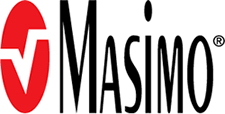
Masimo Also Awarded Prestigious Zenith Award for Third Straight Year

Masimo announced that a new clinical study demonstrating the accuracy of its latest medical technology breakthrough—Rainbow Acoustic Monitoring™—was presented last week at the American Association of Respiratory Care's (AARC) 56th Annual International Respiratory Congress in Las Vegas. The largest gathering of respiratory care clinicians in the world, the AARC Annual Meeting provides an important platform for previewing the latest in medical developments and clinical research to respiratory care thought-leaders.
The study presented by Jim Kumpula, RRT, System-wide Manager of Respiratory Care Services at Swedish Medical Center, evaluated the accuracy of acoustic respiration rate (RRa) measurements, obtained noninvasively with Masimo's Rainbow Acoustic Sensor and continuously displayed on the Radical-7 Pulse CO-Oximeter, in 25 patients on an acute nursing unit in comparison to manual estimates of respiration rate obtained via clinical auscultation (listening to breathing sounds with a stethoscope) and visual observations of patient breathing. After analyzing 187 respiratory rate data pairs collected (7.4 +/- 4.6 data pairs per patient) with bias and precision of 0.8 and 3.4 bpm respectively, Kumpula concluded that Rainbow Acoustic Monitoring was a "simple and automatic method of measuring respiration rate at the bedside, with clinically acceptable accuracy" that could be of "significant value in a wide range of clinical settings including the general care floor, PACU, OR, sleep laboratories, and any care area utilizing conscious sedation."1
Respiration rate is an important vital sign and is especially important for post-surgical patients receiving patient-controlled analgesia (PCA) for pain management as sedation can induce respiratory depression and place patients at considerable risk of serious injury or death.2-5 Although the Anesthesia Patient Safety Foundation (APSF) recommends continuous oxygenation and ventilation monitoring in all patients receiving opioids,6-7 current methods for respiration rate monitoring are limited by reliability or patient tolerance. Early this year Swedish Medical Center became a limited market release site for Masimo's Rainbow Acoustic Monitoring technology, which according to Kumpula has been beneficial.
According to Dr. Michael O'Reilly, Chief Medical Officer at Masimo, "Rainbow Acoustic Monitoring technology provides a new cost-effective solution to address the longstanding and growing need to more accurately and easily monitor patient breathing. This study, from the Swedish Medical Center, underscores the value and impact of this new medical technology tool for significantly improving patient safety and decreasing the cost of care."
Additionally, underscoring the Company's commitment, dedication, and industry leadership in providing best-in-breed, innovative patient care solutions, Masimo received its third consecutive Zenith Award. As the AARC's top industry honor for quality and service excellence, more than 400 companies were eligible for one of five Zenith Award honors. Award winners are chosen by the association's membership—more than 44,000 respiratory care professionals—based upon the quality of the company's equipment and/or supplies, responsiveness, service record, truth in advertising, accessibility and helpfulness of sales personnel, and overall support of the respiratory care profession.
Joe Kiani, Founder and CEO of Masimo, stated, "Confronted with the challenges of delayed lab results, patient tolerance/compliance issues, and time-consuming invasive procedures, respiratory clinicians must provide vital, life-sustaining care for the critically-ill in the face of enormous clinical uncertainty. It is gratifying to see, through studies like this one from Swedish Medical Center, that our noninvasive products and innovative technologies are providing respiratory care clinicians wit

